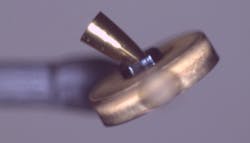Special Targets Boost Intensity of Lasers
Lawrence Livermore National Laboratory engineers devise compound parabolic concentrators (CPC) that increase a laser’s intensity so that laser can accelerate particles so that they experience the effects of relativity. These contractors, essentially special targets, let researchers expand the experimental capabilities of the national Ignition Facility’s (NIF) Advanced Radiographic Capability (ARC) laser. In effect, it lets the ARC laser create effects associated with laser intensities more than 10 times greater than it was designed to deliver.
“The results are significant because it means we can do experiments on ARC that we didn’t think we’d be able to,” says LLNL physicist Andrew MacPhee.
ARC is a powerful short-pulse laser that was designed to operate at about 1018 W/cm2 (1 quintillion watts per square centimeter) on target. However, to accelerate field particles to a significant fraction of the speed of light and see relativistic effects requires considerably more intensity. So, the research team’s goal was to concentrate the energy of ARC’s four beamlets when they arrive during picosecond-scale events inside the target chamber.
Using CPC targets, energy that would otherwise get disbursed into the wings of the ARC focal spot, which extending several hundred microns from the laser axis target, get added to the central high-intensity beam. This puts more energy on the target.
“For ARC, CPCs provide the added bonus of mitigating beam-pointing uncertainty,” MacPhee says. “We have demonstrated excellent signal reproducibility shooting four beamlets into CPC targets.”
CPCs were first used in 1966 to more efficiently collect radiation during high-energy physics experiments. CPCs were then more widely used to concentrate light for making solar power.
For the ARC experiments, researchers combined geometric and refractive focusing of the laser pulse by the expanding cone wall and improving laser absorption from the plasma that forms near the CPC’s tip.
For the first experiments, researchers used the highest-quality targets made by San Diego’s General Atomics, which are gold-coated diamond-turned mandrels. The CPCs measure about one millimeter long with 50- or 25-micron-diameter tips. The cone shaped devices gradually taper inward from the open end.
The cone is truncated near the smaller end and attached to the target, typically a 500-micron-thick gold foil. Beams enter through the larger opening, with the cone’s shape confining the plasma and directing the energy toward the foil at the tip.
One application the CPCs now let ARC handle is characterizing and timing of NIF nuclear and X-ray diagnostics.
“The extremely bright and short X-ray pulses ARC generates with these targets lets us improve our diagnostic measurements, which helped resolve some longstanding discrepancies between diagnostics,” says Shaun Kerr, a postdoctoral researcher with NIF.
Initially, the CPC targets were made by coating a diamond-turned mandrel with gold and dissolving away the mandrel, an expensive and time-consuming process. Researchers have since tested CPCs made by 3D printing. They performed almost as well while reducing manufacturing time and costs, potentially opening the door for their use by other laser researchers.
“Anybody who has a laser with a less-than-ideal focal spot or pointing stability could use targets like thee to reach conditions corresponding to higher effective intensities,” MacPhee notes.
The new CPCs have already opened the door to three high-profile NIF efforts: exploring electron-positron pair production, accelerating protons and making hotter, brighter X-ray sources.

